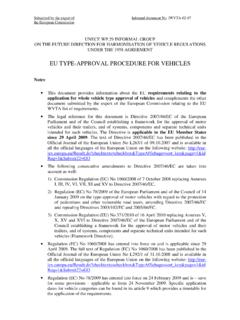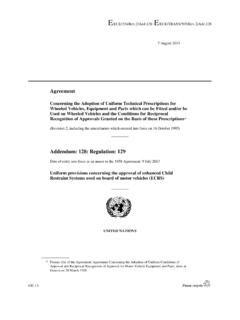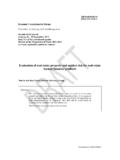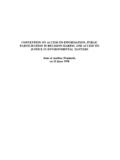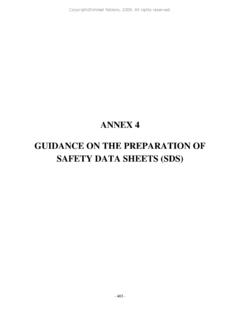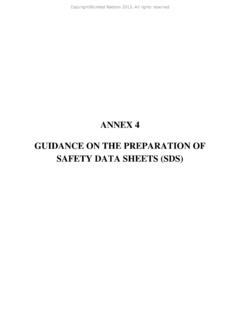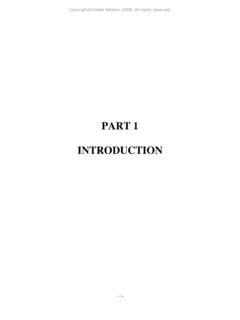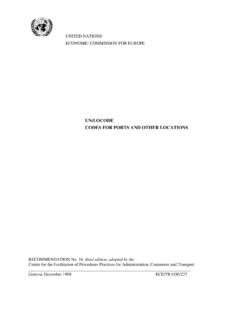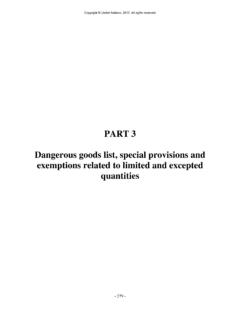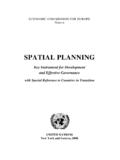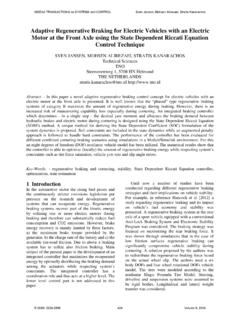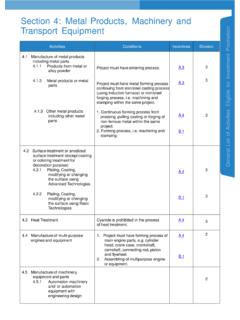Transcription of Agreement - UNECE
1 Agreement Concerning the adoption of uniform technical prescriptions for wheeled vehicles, equipment and parts which can be fitted and/or be used on wheeled vehicles and the conditions for reciprocal recognition of approvals granted on the basis of these prescriptions* (Revision 2, including the amendments which entered into force on 16 October 1995) _____ Addendum 12-H: Regulation No. 13-H Revision 2 Incorporating all valid text up to: Supplement 6 to the original version of the Regulation - Date of entry into force: 15 October 2008 Corrigendum 1 to Revision 1 of the Regulation - Date of entry into force: 24 June 2009 Supplement 7 to the original version of the Regulation - Date of entry into force: 22 July 2009 Corrigendum 1 to Supplement 7 to the original version of the Regulation - Date of entry into force: 22 July 2009 Supplement 8 to the original version of the Regulation - Date of entry into force: 24 October 2009 Supplement 9 to the original version of the Regulation - Date of entry into force: 17 March 2010 Supplement 10 to the original version of the Regulation - Date of entry into force.
2 9 December 2010 Supplement 11 to the original version of the Regulation - Date of entry into force: 30 January 2011 Corrigendum 1 to Supplement 9 to the original version of the Regulation - Date of entry into force: 22 June 2011 Uniform provisions concerning the approval of passenger cars with regard to braking _____ UNITED NATIONS * Former title of the Agreement : Agreement Concerning the Adoption of Uniform Conditions of Approval and Reciprocal Recognition of Approval for Motor vehicle Equipment and Parts, done at Geneva on 20 March 1958. E/ECE/324 E/ECE/TRANS/505 4 October 2011 E/ECE/324 E/ECE/TRANS/505 3 Regulation No. 13-H Uniform provisions concerning the approval of passenger cars with regard to braking Contents Page Regulation 1.
3 5 2. 5 3. Application for approval .. 9 4. Approval .. 9 5. Specifications .. 11 6. Tests .. 23 7. Modification of vehicle type or braking system and extension of 23 8. Conformity of 24 9. Penalties for non-conformity of production .. 24 10. Production definitely 24 11. Names and addresses of Technical Services responsible for conducting approval tests, and of Administrative Departments.
4 24 12. Transitional 24 Annexes 1 Communication concerning the approval or extension or refusal or withdrawal of approval or production definitely discontinued of a vehicle type with regard to braking pursuant to Regulation No. 13-H .. 26 Appendix - List of vehicle data for the purpose of regulation No. 90 approvals .. 29 2 Arrangements of approval marks .. 30 3 Braking tests and performance of braking systems .. 31 Appendix - Procedure for monitoring the state of battery 39 4 Provisions relating to energy sources and energy storage devices (energy accumulators) .. 40 5 Distribution of braking among the axles of vehicles .. 42 Appendix 1 - Wheel-lock sequence test procedure.
5 46 Appendix 2 - Torque wheel test procedure .. 48 6 Test requirements for vehicles fitted with anti-lock systems .. 51 Appendix 1 - Symbols and definitions .. 57 Appendix 2 - Utilisation of adhesion .. 59 E/ECE/324 E/ECE/TRANS/505 4 Appendix 3 - Performance on differing adhesion surfaces .. 62 Appendix 4 - Method of selection of the low adhesion surface .. 63 7 Inertia dynamometer test method for brake 64 8 Special requirements to be applied to the safety aspects of complex electronic vehicle control 67 9 Electronic stability control systems and brake assist systems .. 72 Appendix 1 - Use of the dynamic stability simulation .. 88 Appendix 2 - Dynamic stability simulation tool and its validation.
6 89 Appendix 3 - vehicle stability function simulation tool test report .. 91 Appendix 4 - Method for determination of FABS and aABS .. 92 Appendix 5 - Data processing for the BAS .. 94 E/ECE/324 E/ECE/TRANS/505 5 1. Scope This Regulation applies to the braking of vehicles of categories M1 and N1 1. This Regulation does not cover: Vehicles with a design speed not exceeding 25 km/h; Vehicles fitted for invalid drivers. 2. Definitions For the purposes of this Regulation, "Approval of a vehicle " means the approval of a vehicle type with regard to braking. " vehicle type" means a category of vehicles which do not differ in such essential respects as: The maximum mass, as defined in paragraph below; The distribution of mass among the axles; The maximum design speed; A different type of braking equipment, with more particular reference to the presence or otherwise of equipment for braking a trailer or any presence of electric braking system; The engine type; The number and ratios of gears; The final drive ratios; The tyre dimensions.
7 "Braking equipment" means the combination of parts whose function is progressively to reduce the speed of a moving vehicle or bring it to a halt, or to keep it stationary if it is already halted; these functions are specified in paragraph below. The equipment consists of the control, the transmission, and the brake proper. "Control" means the part actuated directly by the driver to furnish to the transmission the energy required for braking or controlling it. This energy may be the muscular energy of the driver, or energy from another source controlled by the driver, or a combination of these various kinds of energy. "Transmission" means the combination of components comprised between the control and the brake and linking them functionally.
8 The transmission 1 This Regulation offers an alternative set of requirements for category N1 vehicles to those contained in Regulation No. 13. Contracting Parties that apply both Regulation No. 13 and this Regulation recognize approvals to either Regulation as equally valid. M1 and N1 categories of vehicles are defined in the Consolidated Resolution on the Construction of Vehicles ( ), document ECE/ , para. 2 E/ECE/324 E/ECE/TRANS/505 6 may be mechanical, hydraulic, pneumatic, electric or mixed. Where the braking power is derived from or assisted by a source of energy independent of the driver, the reserve of energy in the system is likewise part of the transmission. The transmission is divided into two independent functions: the control transmission and the energy transmission.
9 Whenever the term "transmission" is used alone in this Regulation, it means both the "control transmission" and the "energy transmission": "Control transmission" means the combination of the components of the transmission which control the operation of the brakes, including the control function and the necessary reserve(s) of energy; "Energy transmission" means the combination of the components which supply to the brakes the necessary energy for their function, including the reserve(s) of energy necessary for the operation of the brakes. "Brake" means the part in which the forces opposing the movement of the vehicle develop. It may be a friction brake (when the forces are generated by friction between two parts of the vehicle moving relatively to one another); an electrical brake (when the forces are generated by electro-magnetic action between two parts of the vehicle moving relatively to but not in contact with one another); a fluid brake (when the forces are generated by the action of a fluid situated between two parts of the vehicle moving relatively to one another); or an engine brake (when the forces are derived from an artificial increase in the braking action, transmitted to the wheels, of the engine).
10 "Different types of braking equipment" means equipment which differ in such essential respects as: Components having different characteristics; A component made of materials having different characteristics, or a component differing in shape or size; A different assembly of the components. "Component of the braking equipment" means one of the individual parts which, when assembled, constitutes the braking equipment. "Progressive and graduated braking" means braking during which, within the normal operating range of the device, and during actuation of the brakes (see paragraph below): The driver can at any moment increase or decrease the braking force by acting on the control; The braking force varies proportionally as the action on the control (monotonic function); The braking force can be easily regulated with sufficient precision.
